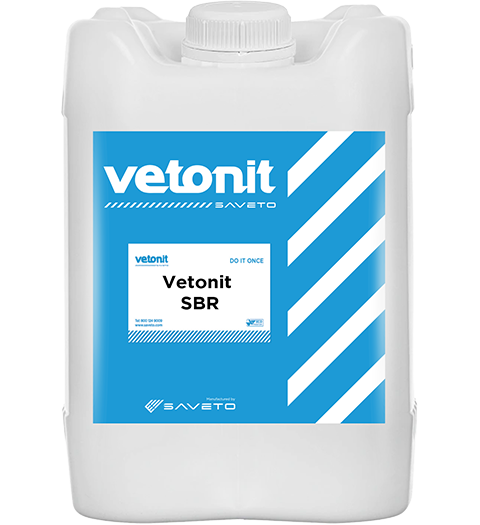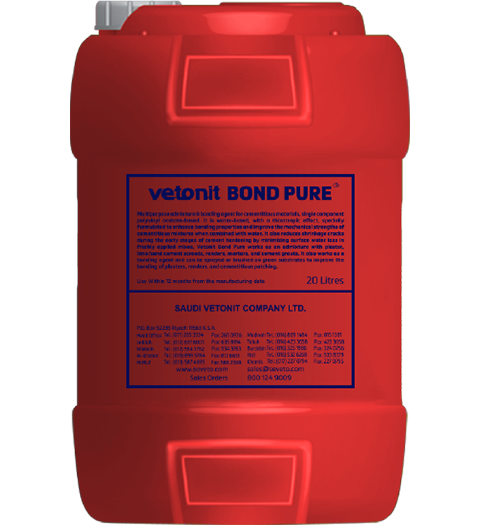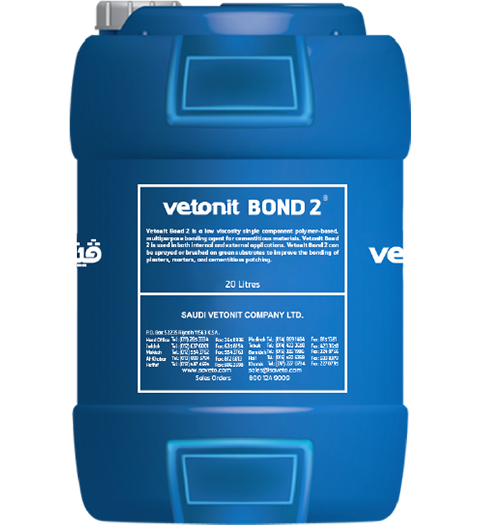Vetonit SBR
Polymeric bonding agent, waterproof mix, mortar cohesion enhancer & primer.
Vetonit SBR is a modified styrene-butadiene rubber (SBR) latex that is supplied as a ready-to-use white liquid. It is designed to improve the quality of site-batched cementitious mortars and slurries. When used as a primer; it works to seal the substrate and enhance bond to mortars and plasters. Being resistant to hydrolysis, it is ideal for internal and external applications in conjunction with cement.

Uses
- Production of high-strength waterproof renders, screeds, cement slurries and mortars.
- Enhancing cementitious mixes (such as plasters, tile adhesives, screeds, etc).
- As a primer and surface sealer for plasters and repair mortars.
- Enhancement of cementitious mixes to freeze and thaw cycles.
- Bonding old to new concrete.
Advantages
- Factory controlled single component easy to use and easily gaged.
- Water emulsified, environment friendly product.
- Odorless and non flammable.
- Resistant to hydrolysis, used externally and internally.
- Improves mortars to provide waterproof repairs, renders and toppings which are highly resistant to freeze/thaw cycling.
- Improved tensile and flexural properties allowing thin applications.
- Excellent bond to concrete, masonry, stonework, plaster and block walls.
- Priming gypsum boards to allow installation of cementitious tile adhesives.
- High viscous polymeric bonding agent for admixture.
Usage Instructions
Saw cut the extremities of the repair locations to a depth of at least 10 mm to avoid feather edging and to provide a square edge. Break out the complete repair area to a minimum depth of 6 mm up to the sawn edge.
Clean the surface and remove any dust, unsound or contaminated material, plaster, oil, paint, grease, corrosion deposits or algae. Where breaking out is not required, roughen the surface and remove any laitence by light scabbling or grit blasting.
Oil and grease deposits should be removed by steam cleaning, detergent scrubbing or the use of a proprietary degreaser. The effectiveness of decontamination should then be assessed by a pull-off test.
Expose fully any corroded steel in the repair area and remove all loose scale and corrosion deposits. Steel should be cleaned to a bright condition paying particular attention to the back of exposed steel bars. Grit blasting is recommended for this process.
Where corrosion has occurred due to the presence of chlorides, the steel should be high-pressure washed with clean water immediately after grit blasting to remove corrosion products from pits and imperfections within its surface.
Apply one full coat of Vetoprime CP437 to any exposed steel reinforcement and allow to dry before continuing. If any doubt exists about having achieved an unbroken coating, a second application should be made and, again, allowed to dry before continuing.
The substrate should be thoroughly soaked with clean water and any excess removed prior to commencement. A slurry primer should be prepared consisting of 1 volume Vetonit SBR to 1 volume clean water to 3 volume fresh cement. To obtain a smooth consistency, the cement should be blended slowly into the premixed liquids. The slurry primer should be stirred frequently during use to offset settlement.
The slurry primer should be scrubbed well into the surface of the concrete. Avoid applying too thickly and avoid ‘puddling’.
The repair mortar, topping or render must be applied on to the wet slurry primer. If the slurry primer dries before application of the mortar, it must be removed and the area reprimed before continuing.
In exceptional circumstances, e.g. where a substrate/ repair barrier is required or where the substrate is likely to remain permanently damp, Vetobond EB430 bonding aid should be used.
Contract the local Saveto office for further information.
Care should be taken to ensure that Vetonit SBR mortars are thoroughly mixed. A forced-action mixer is essential.
Mixing in a suitably sized drum using an approved spiral paddle in a slow speed (400/500 rpm) heavy-duty drill is acceptable for occasional use.
A wide range of mix designs is achievable using Vetonit SBR. Typical designs are detailed below:
1. Patching and repair mortar (Recommenced thickness 6 mm to 40 mm) 50 kgs Ordinary Portland Cement 150 kgs grade C/M sharp sand 10 liters Vetonit SBR 8 liters (approximately) clean water
2. Heavy-duty floor screed (Recommended thickness 10 mm to 40 mm) 50 kgs Ordinary Portland Cement 75 kgs 3 mm to 6 mm granite chips 75 kgs grade C/M sharp sand 10 liters Vetonit SBR 6 liters (approximately) clean water The screed should be of a semi-dry cohesive consistency.
3. Render (Recommended thickness 6 mm to 9 mm) 50 kgs Ordinary Portland Cement 150 kgs grade C/M sharp sand 10 liters Vetonit SBR 6 liters (approximately) clean water The render should be of a semi-dry cohesive consistency.
4. Bonding mortar for slip bricks, tiles, etc: 50 kgs Ordinary Portland Cement 125 kgs grade C/M sharp sand 10 liters Vetonit SBR 7 liters (approximately) clean water.
Water is adjusted to give a firm mortar. For fine joints, use grade M/F sand. Support where necessary until the mortar is set.
The recommended thickness 6 mm to 40 mm.
Note: The mix designs are based on the use of dry sand and aggregate. Adjustments must be made to the water demand relative to the moisture content of the sand and aggregate used. It should also be noted that, due to the frequent inconsistencies of site stored materials and variable conditions, actual results may differ from those published above.
Weigh the cement, sand and, where required, aggregate into the mixer and dry blend together for one minutes. With the machine in operation, add the pre-mixed Vetonit SBR and clean water. Continue mixing for 3 minutes to ensure complete dispersal into the sand and cement. Make any small adjustment to the quantity of clean water but do not significantly exceed the amount shown above. Additional water should be kept to a minimum. Continue mixing up to a maximum of 5 minutes until a smooth and fully homogeneous consistency is achieved with the required workability and application properties. It is critical that allowance is made for the moisture content of the sand and aggregate, particularly where they are stored on site.
For application to all surfaces, Vetonit SBR mortars, toppings and renders must be well compacted on to the primed substrate by trowel. It is frequently beneficial to work a thin layer of the mortar into the slurry primer and then build the mortar on to this layer. Exposed steel reinforcement should be completely encapsulated by the mortar.
Vetonit SBR mortars can be applied at a minimum thickness of 6 mm and up to 40 mm thickness, dependent on the location and configuration of the repair zone. The thickness achievable in overhead locations without the use of formwork is largely dependent on the profile of the substrate.
Refer to the recommended thicknesses shown in the ‘Mix design’ section above. If the recommended thickness is exceeded and sagging occurs, the affected section must be completely removed and reapplied in accordance with the procedure described above. The use of formwork may facilitate achieving the required build. If formwork is used, it should have properly sealed faces to ensure that no water is absorbed form the repair material.
Where thicker sections up to a total thickness of 40 mm are to be built up by hand or trowel application, the surface of the intermediate layers should be scratch-keyed and cured with Vetobond AB432. Application of the slurry primer and a further application of Vetonit SBR mortar may proceed as soon as this layer has set.
Vetonit SBR mortars can be finished with a steel, plastic or wood float, or by a damp sponge technique, to achieve the desired surface texture. The completed surface should not be overworked.
In cold conditions down to 5°C, the use of warm water (up to 30°C) is advisable to accelerate strength development. Normal precautions for winter working with cementitious materials should then be adopted.
At ambient temperatures above 35°C, the material should be stored in the shade and cool water used for mixing.
Vetonit SBR mortar, toppings and renders are cement based. In common with all cementitious materials, they must be cured immediately after finishing in accordance with good concrete practice. The use of Vetocure XT426, sprayed on to the surface of the finished mortar in a continuous film, is recommended. In harsh drying conditions, supplementary curing with polythene sheeting must be used.
Vetonit SBR mortar repairs are extremely durable and will provide excellent protection to the embedded steel reinforcement within the repaired locations. The surrounding parts of the structure will generally benefit from the application of a barrier/decorative coating to limit the advance of chlorides and carbon dioxide, thus bringing them up to the same protective standard as the repair itself.
Saveto recommend the use of the Vetotouch range of protective, anti-carbonation coatings. These products provide a decorative and uniform appearance as well as protecting areas of the structure which might otherwise be at risk from the environment. Vetotouch products may be applied over the repair area without prior removal of the Vetobond AB432 curing membrane. This is best achieved by light grit or sandblasting.
Clean tools with water promptly before material hardens. Hardened material can be mechanically removed.








